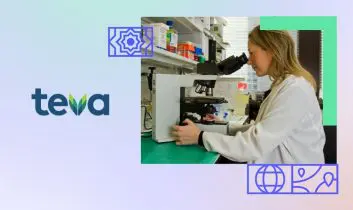
Inside BLEND: How Our Head of Customer Support Runs The Show
While BLEND’s community of linguists is hard at work helping companies around the globe translate their customer support content, our own support team is working behind the scenes to help our customers better utilize our localization services, technology, and self-service translation platform. We sat down with Katya, BLEND’s very own Head of Support, to get a look into how they do it – including how we utilize some of the same localization technology that we offer our clients.
Hi Katya, thanks for taking to the time to talk to me! First, can you tell me a little about yourself and your career – how did you come to be the head of support at BLEND?
I started working in customer support 8 years ago after I finished my Master’s degree in French Linguistics. At the time, it felt like a good fit for me because I wanted to do something light, and back then it was required to speak three or more languages – though that’s not the case anymore. Then, I joined BLEND as a customer support representative, but I had previous managerial experience in customer service, so I was promoted pretty quickly to Support Manager and then to Head of Support, and that’s where I’ve been for the last two and a half years.
Impressive! Tell me a bit about BLEND’s customer support team and the main ways they communicate with and address customer concerns.
We actually have 16 people on the team, including six Shift Managers. The majority of our team sits here in Kyiv, but we also have three team members in the Tel Aviv office, and one who works from the Dominican Republic. But with the company growing so rapidly, we plan to hire more CSRs in the US to serve our growing client base there and cover more time zones. I’ve hand-selected everyone on the team, to make sure that they are not only the best professionals in the industry, but that they also share our company values.
We have two main support channels – chat and email – along with a lesser-used answering service. Email is definitely our preferred method of communication, as it allows the team more time to look into an issue thoroughly and get back to the client with the most helpful response possible. It also tends to be the most popular form of communication, just due to the nature of the industry.
The principle that underlies our work is that the best customer service is when the customer doesn’t have to contact support.
I know your team also utilizes the Zendesk multilingual helpdesk application, which is a technology that we offer our clients as well. Tell me a bit about how that works, and how it’s affected the way your team does their job.
It’s actually a really helpful and efficient tool. Essentially, it works by detecting the language used by the customer in their email to us, and translates it automatically to English. From there, our CSRs can handle the support ticket and write their response, which is then translated back into the customer’s language before it’s sent to them.
Before this, we relied on tools like Google translate, and so much got lost in translation. It’s not a tool that can read the nuance of a language or the customer’s sentiment, so we had no idea how they felt about our replies. Sometimes we might have thought we were answering someone politely, but to them, in their language, it actually sounded rude. So, this is much more advanced machine translation and it really helps us do our jobs better.
Plus, if it’s a very sensitive dispute, we can now also opt to use human translation or NMTPE. In these cases, we can send the ticket through the Zendesk app to one of our own BLEND translators, and then the translated reply will be sent directly to the customer without the need for further support agent involvement.
How has our customer support changed over the years, and what are the ways you feel it’s improved?
We actually made a lot of very structured improvements. The first one is that we have built a wonderful team of individuals who are smart and passionate about what they do. The principle that underlies our work is that the best customer service is when the customer doesn’t have to contact support; so they make sure not only to handle the complaints, but to escalate them to myself or the relevant department to address underlying issues that can improve the customer experience. We’ve also implemented a highly structured KPI system that tracks their progress, and we make sure that every effort is rewarded.
And finally, as we spoke about, one of the biggest changes was upgrading to Zendesk, which allows us to implement better support processes. It also allowed us to switch to data-driven KPIs and decision-making. The data lets us analyze team and individual work, and identify our weak spots that need improvement. We’ve also implemented a customer satisfaction survey that every customer can submit after they interact with us, which allows them to mark the service as good or bad, and leave a comment. Then we use this feedback to improve as well.
How do you address feedback that doesn’t have to do with your team’s response, but with our product or services themselves?
We look at the nature of all the requests to see what the top issues are that appear over and over again. If it’s an issue on the product level, I work with the product team to resolve it. If it’s an issue with the internal process of how a project is handled, we work with the operations team to improve this for the future. There is a lot of cross-departmental collaboration going on behind the scenes to improve the customer experience.
Now that BLEND has shifted to expand our enterprise localization offerings, in addition to having our established self-service translation platform, how has that affected the types of requests and customers you deal with?
For the customers that use our self-service translation platform, we are still the only point of contact, so not much has changed. The bigger business clients have their project managers, so we don’t necessarily talk to the client, but we still help to make sure that the project runs smoothly. For example, if there is a delay in the project getting started, we contact the translator and ask them to start working on it. Our team is cross-trained to handle all sorts of requests that come in, which allows us to respond quickly, without waiting for the help of someone who may not be working that shift.
I highly recommend that all support managers spend a couple hours a week working as a CSR on real complaints from your customers to see how you can improve the process from a manager’s perspective.
As a localization company, we are of course always interested in how different aspects of business very throughout the world. Do you find that there are major differences between the types of requests that come in from different regions, or the way they prefer to communicate?
Yes. Usually, customers from Western countries prefer to contact us via chat or phone – or sometimes even via social media – while customers from Eastern countries prefer to contact us via email, or they use our Help Center to find an article to assist them, rather than approaching us directly. This is definitely a generalization, and isn’t always true – but as I said, we have data on everything now, and the data supports it. So it’s an interesting observation.
The bottom line is to always look for more ways to improve – as long as your company still needs a customer support team, the work is never done.
What advice to do you have for other support managers at global companies who are trying to improve their customer support?
The first thing I would say is to collect and analyze multi-factor data to see where your weak spots are. The second would be to ask your team for feedback constantly, as this promotes psychological ownership, and it has a long-lasting, positive effect on their work.
And third, I highly recommend that all support managers spend a couple hours a week working as a CSR on real complaints from your customers to see how you can improve the process from a manager’s perspective. It may not be a very popular idea or something that managers want to take the time to do, but I can say that over the years, doing this has given me a lot of great insights and stopped me from making many bad managerial decisions.
The bottom line is to always look for more ways to improve – as long as your company still needs a customer support team, the work is never done.
Need fast, high-quality translation?
Translate nowWhat our customers are saying











